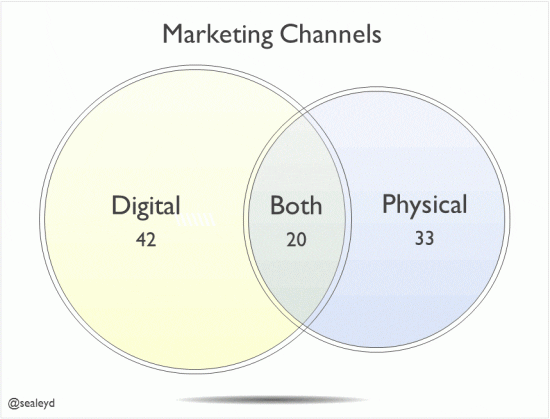How to assess the contribution of different communications touchpoints
In my last post for Smart Insights I published a complete list of today's channels. Thanks to some comments and suggestions , the channel list has reached 106 channels so far. 95 of these are suitable for marketing purposes be they physical, digital or a bit of both. This is the way they break down.

Venn Diagram of Marketing Channels
Naturally there are at least two questions that arise when faced with such channel choice.
Firstly, how do you pick which channel to use? And then secondly, how do you measure the combined performance across channels? The latter question of course relates to the tricky issue of attribution - the apportioning of sales revenue to the channels that lead up to the sale.
Back in 2010, Dave Chaffey reported the following statement in an interview with Gary Angel which I wholeheartedly agree with:
"Attribution remains a significant issue for clients. In our view, there is no one right answer to attribution. We all know that first or last doesn’t cut it. But it turns out that channels interact quite differently for different organizations. It also turns out to be nightmarishly difficult to produce coherent reports on channel interactions that capture anything like reality."
Three years on and I don't think the industry has really solved this issue (I'd love to hear with anyone who disagrees with this in the comments).
Google Analytics has begun to move things forward (see this incredible post by Avinash Kaushik for a guide to attribution in Google Analytics) it still does not solve all of the marketer's woes. This is especially true when we start to consider both indirect channels and retention/engagement based activities.
Planning to Attribute
It seems to me though that the foundation for attribution success is to plan to create the data required to measure attribution before the campaigns are executed.
For example, use a different URL in TV adverts (e.g. www.mybrand.tv) and ensure that the voucher codes you send out are tied to a specific customer and distribution channel.
Especially ensure that any affiliate links are tagged correctly for your web analytics package. One of the frequent complaints I hear about the affiliate channel is that it fails to attract new customers. For this reason ensure that your e-commerce database or CRM is tracking what attributed to each customer's sale. This is a tall order but it could save you a lot of grief when wondering whether or not to continue with Quidco-esque affiliates.
This discipline of meticulous tagging and tracking should be an essential part of campaign planning.
Custom Reporting Solutions
With all this data collected a custom reporting solution is often required outside of the web analytics suite to measure the individual impact of each channel on the overall conversion. Whilst there are standard models of attribution modelling, it's unlikely that one of these will fit your business requirements exactly. You'll probably need to create a bespoke model based on channels that are adding the right types of traffic (e.g. product bloggers).
The crucial point with the reporting solution is to try and bring together an entire picture of how all of your marketing channels are generating revenue. 99% accuracy is not necessarily the objective but the models should be based on repeatable assumptions and rules. After all the big picture to a less than accurate level is going to be more useful for planning than a single channel measured to complete precision.
Don't Get Lost in the Weeds
I used to work with a CMO who'd say "don't let perfect get in the way of good". Her point was that the commercial realities of trading a website were far more important than achieving absolute perfection. Some may say that this attitude could create an acceptance of sloppiness or poor quality.
This wasn't the case. Instead it created expected quality levels designed around an execution oriented process. No more endless rounds of creative reviews.
My concern with those attempting to solve the problem of attribution tracking is that an analyst could lose themselves in a cycle of endless tweaking. When it's looking too complex, bear in mind that there are alternatives such as the use of control groups to measure the incremental impact of channels. Email and direct mail are great candidates for this treatment.
Summary
There's still no silver bullet but the analytics tools are getting better at tracking and reporting on attribution across digital channels. Ultimately, as the tools improve there will be still be difficulty in selecting between models and deciding how much weight to apportion to brand traffic vs non-brand.
In the short-term, plan to get attribution right by configuring the right tagging and tracking across your campaign plans. Also test out control group experiments to see what uplift if any your are achieving. Experiment as well with these control groups to see if the findings are repeatable. If the experiments turn out consistent results then you are beginning to find winning media mixes that can be expanded in to your wider marketing operations.
If you're interested in attribution, you can meet me at an Adobe-cum-Neolane sponsored breakfast seminar on Wednesday 27th November. Details and registration here.








